1963 South African Grand Prix race report: Clark's finish fantastic
Jim Clark dominates once again to take a seventh victory of the 1963 season

Clark, Brabham and Gurney lead the field away
Motorsport Images
Once again the final race in the World Championship series of Formula One events took place at East London on the warm sunny South East coast of Africa. However, unlike last year, the race was to mean nothing in placings for both drivers’ and manufacturers’ championships.
The circuit was unaltered since 1962 but due to the suspected increase in speed three laps were added this year making a total of 85 laps – 207.02 miles.
With the high cost of transporting drivers, cars and mechanics to South Africa, the RAC of SA invited two cars from each of the main teams, with one European private entry, the rest all being local boys. Team Lotus had two 25s for Clark and Taylor, the former’s being his own reliable car, while Taylor’s was the new car built and used at the Earls Court Exhibition. In the recent Rand GP the sun had been so hot that fuel was vaporising in the Lucas pressure pump. To stop this happening at East London the pump of both cars was moved in front of the radiator, so it had the coolest air moving over it.
Ferraris were here for the first time with three cars for Surtees and Bandini. Two cars were the latest V6 monocoques while the third training car was an older V6 with tubular chassis. Surtees’ car had a long Perspex screen while Bandini’s had a shorter, more upright screen. On all cars the steering joints had been heavily greased and then sealed with polythene covers to stop the sand and heat affecting the steering. The troubles that had been experienced at Mexico were more or less ironed out in a series of minor chassis and suspension modifications.
BRM were fielding the same cars as they had at this race last year. With development progressing steadily on the new car, BRM had sent only three mechanics and the two drivers this year. The rest of the team, no doubt, were otherwise profitably engaged. Brabham had entered two cars for himself and Gurney, neither being altered since the last race.
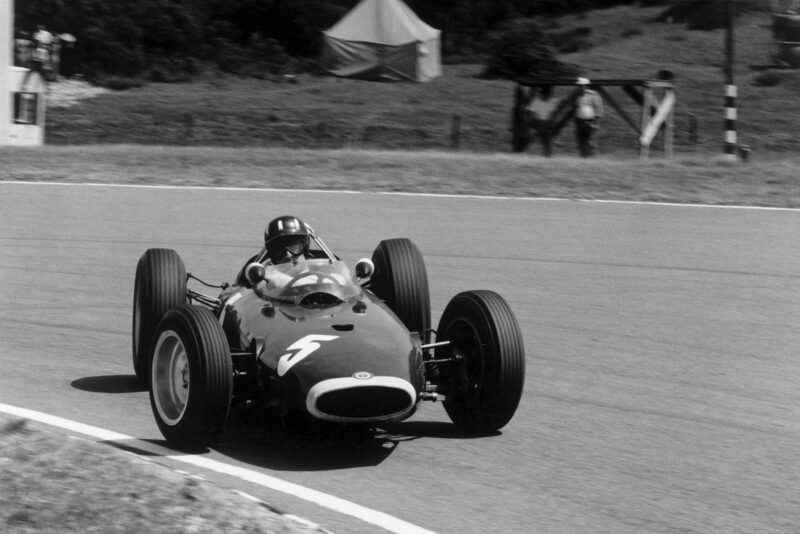
Hill tests the limit of adhesion
Motorsport Images
The Cooper team was also unaltered, with McLaren and Maggs driving the usual cars. The only difference between them was that Maggs’ car was fitted with the flat crank engine, while McLaren had the ordinary engine. The only other confirmed European entry was Bonnier in RRC Walker’s Cooper-Climax. This was unaltered for its last championship event for next year Bonnier is to drive Walker’s new Brabham-BRM.
The local private entries had a very varied collection of bits and pieces the only thing in common being the Dunlop tyres. E Pieterse had a Lotus with a 4-cylinder Climax engine. Paddy Driver had a Lotus-BRM V8 with Weber carburetters and a Colotti box. L D Serrurier was entered in two cars with two different numbers but he only had one car at practice, that being his LDS-Alfa. This has a bored-out Giulietta engine giving 1,497cc with two twin-choke Webers. The gearbox is a 5-speed Hewland.
P de Klerk had entered a nicely finished Alfa Special with a bored-out Giulietta engine and 5-speed Porsche box. J Love had his 1961 Cooper-Climax 4-cylinder, now with AEC transistor ignition. SA Tingle also had an LDS-Alfa similar to Serrurier’s. B Niemann was to drive a Lotus-Ford Junior 1500 with a 5-speed Hewland gearbox. At the weigh-in this car needed 140lb of lead to bring it up to weight. DMD Prophet had a Brabham-Ford Junior also with a Cosworth 1500 Ford engine and 5-speed Hewland box. Last of the locals was T Blokdyk, who had an old Cooper-Maserati.
This should have been the full entry, but de Beaufort, who had been politely refused an entry from a finance point of view, just turned up. After some wrangling he was told he could take over Hailwood’s entry as the Lola would not be arriving, but he must qualify at 1min 37sec as all the other drivers. The organisers seemed to be on a certainty that he wouldn’t start as his best lap last year timed in the same car was only 1min 39.3sec.
Qualifying
First practice was attended by all cars and took place on Boxing Day at 1:30pm on a hot afternoon with a cool breeze coming off the Indian Ocean. First out were Taylor, McLaren and Clark. The targets that were set for them last year were 1min 31sec, fastest race lap, and 1min 28.9sec, fastest practice lap, both set by Clark, the practice time being in last year’s training car.
Both Lotuses were quickly back in the pits with gear selector trouble which was partially rectified, although Clark was having difficulty with third gear right through practice. Surtees started the ball rolling with 1min 32.9sec, soon followed by Hill with 1min 32.4sec. The two monocoque Ferraris were not handling very well so Bandini used the spare car, while Surtees tried to sort out the trouble. Clark went out in both Lotuses and did 1m 31.8sec in each.
After the first flood of practice, work in the pits started sorting out problems, Hill’s BRM had its gear ratios changed, as did Surtees’ Ferrari. Brabham was behind the pits trying to cure a slipping clutch. Blokdyk was in curing an oil leak which had made the circuit slippery. Some of the pit-work of the locals was very amateurish; for example, every time Pieterse wanted to raise or lower his tyre pressures he changed wheels, which meant no check on tyre wear could be kept.
Ginther had a slight split in his radiator which was going to necessitate welding after practice. Surtees was the first driver to break 1min 30sec when he did 1min 29.8sec although the handling of the Ferrari was still not very good. A number of the private entries qualified in the first practice, but de Beaufort, Driver and Prophet were unable to get below 1min 37sec. Practice finished with Surtees still fastest with Brabham and Gurney close behind. Hill’s BRM was breathing a lot of oil which indicated an internal breakage, so the engine had to be changed.
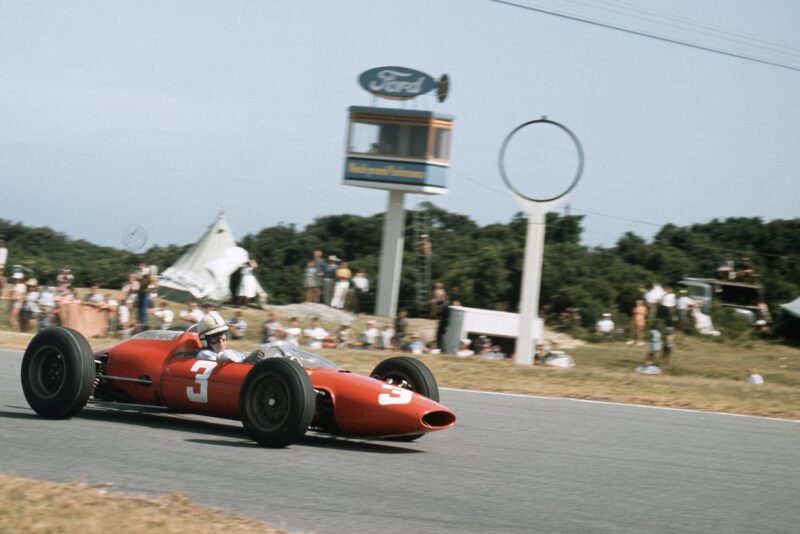
Surtees was the first driver to get under 1min 30sec
Motorsport Images
Next session was at 6am next morning; for this all cars did not turn up, although with the cooler atmosphere faster times were likely. Bonnier, Love, Tingle arid Blokdyk were the four absentees. The weather was cool with a slight breeze. First out was Clark, with his gears now working properly. Within five minutes he was in his stride and in about 20 laps he did most of them in 1min 29sec, and one in 1min 28.9sec, which equalled his last year’s time. Unfortunately on what he thought would be the fastest, the gear selector broke as he was engaging third gear and the car was wheeled away. As Clark was finishing both Brabhams were out putting in some very fast laps resulting in 1min 29sec and 1min 29.1sec for Brabham and Gurney, neither of the works Coopers were going very fast but neither were they giving any trouble.
The Ferraris were set a little lower at the front but Surtees could not better his previous time. Prophet started away from the pits but stopped within 200 yards with a bent valve so his mechanic took off the head in the pits and replaced the valve; de Beaufort managed to get below the qualifying speed with a time of 1min 36.6sec. Driver also qualified, thus leaving Prophet the only one still out after the second practice.
Final practice was 6 1/2 hours later, and by this time the sun was well out, the temperature high, and a strong wind blew in from the sea. The likelihood of increased times was therefore negligible. However, by trying very hard and giving a demonstration of opposite lock slides at many of the corners, Hill bettered his time by a tenth of a second while his team-mate managed to clip a further 0.8sec off. Prophet, after many laps of misfiring, finally did 1min 35.5sec which got him in. Driver was going fast down the straight when a steering arm broke causing the car to leave the road and roll, but fortunately he was unhurt; the car however was a complete wreck, with the front end almost torn completely off.
Clark did not better his morning’s time but he was satisfied with the car at last and was able to use the elusive third gear. Ferrari were still not happy. The engine torque low down was so bad that both drivers were losing a lot of time coming out of the corners.
Practice finished at 4pm with Clark, Brabham and Gurney on the front of the grid. Most cars just needed preparation for the race but McLaren had broken the crownwheel and pinion and this was replaced overnight. De Beaufort also had trouble as a valve was bent and so without the aid of mechanics the big Dutchman changed the engine himself, took it out on the road to test, and was given a ticket by an anti-racing policeman.
Race
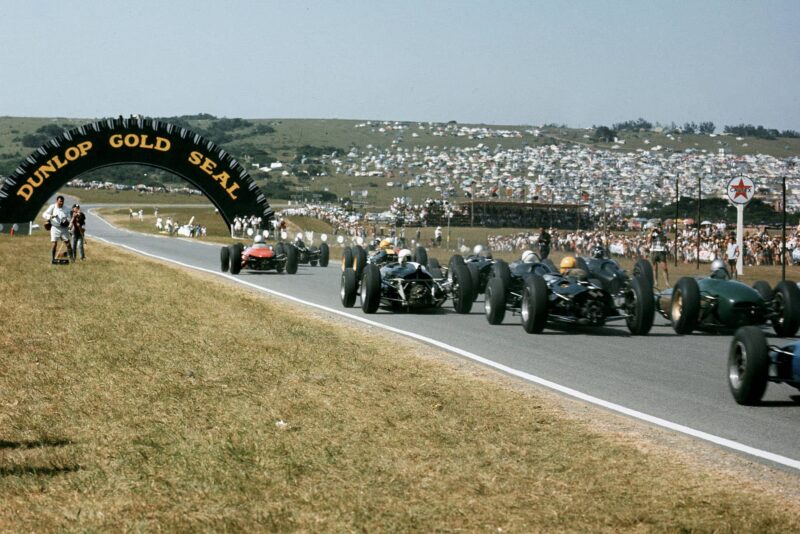
The gaggle races off
Motorsport Images
Race day was hot and windy, so windy that at times some gusts were almost at gale force. Before the Grand Prix, the organisers had a national speed feast in the form of two motorcycle races and two car races, but these were finished by lunch time and the Formula cars began warming up in the paddock. Surtees’ Ferrari developed an electrical fault which threw the whole team into a panic, for nearly two hours they tried everything they knew to get the charge to the battery. All components were changed, wiring examined, and just as the cars were being wheeled on to the grid the charge suddenly returned and the tension in the Ferrari equipe relaxed.
The cars formed up on a false grid and with 30sec to go they rolled forward to the starter, all engines were running and at 3pm the flag fell and the 10th South African Grand Prix was on.
Although Brabham jumped ahead down the straight it was Clark who led at the end of the first lap from Surtees and the two Brabhams. Behind them came Taylor, Bandini, McLaren, Ginther, G Hill made a poor start and lay ninth with Maggs, Bonnier and Love close behind. The tail-enders were already stringing out and Pieterse led from Tingle, Serrurier, Prophet, Nieman, Blokdyk, de Klerk and de Beaufort. The second lap order remained the same. Nieman came into the pits with a jammed gearbox which was eventually freed.
The lead remained unchanged for the next two laps with Clark pulling out a tremendous lead over Surtees and the two Brabhams, who were trying to pass the Ferrari. On lap 3 Tingle retired with a broken drive shaft. On lap four with a haze of smoke pouring from the back, Pieterse brought his Lotus-Climax into the pits to retire with a hole in a cam box, caused by a nut shearing and being shot through the cover.
The lead on lap five was still the same, although now the Brabhams were beginning to nose the Ferrari out of the way. Bandini, lying sixth, overdid it on one corner, letting McLaren, Ginther and Hill past. Next lap, first of all Brabham then Gurney forced their way past the Ferrari who signalled his pits that all was not quite well.
Taylor, who was lying fifth, arrived in the esses without being able to engage a gear, he spun and, before getting under way again, he had dropped to 10th place behind Maggs who was having gear troubles of his own. Brabham’s efforts to get past the Ferrari did something to the engine which dropped 700revs, slowing Jack down considerably. On lap 7 he was passed by Gurney and five laps later Surtees repassed into third place.
“Taylor, who was lying fifth, arrived in the esses without being able to engage a gear, he spun and, before getting under way again, he had dropped to 10th place”
In eighth and ninth places Maggs and Bandini were having quite a tussle. On laps 5 and 6 Bandini led, then Maggs passed the Ferrari which was also passed by Taylor, beginning to make up for his spin. On lap 9, Taylor passed Maggs and Bandini closed up right on to Maggs’ tail. Next lap he passed and although Maggs pressed him hard, he was unable to regain his lead.
By 10 laps Clark was 11sec ahead of Gurney and lapping in 1min 30.8sec. As Brabham began to slow so Hill began to gain on him, with McLaren and Ginther just behind. On lap 15 Hill passed the Brabham and Ginther passed McLaren. Three laps later the number two BRM moved into fifth place behind Hill as Brabham dropped back a bit further. One lap later Taylor passed the Brabham and positions settled down for another 10 laps. D Prophet made some slow progress passing Blokdyk and de Klerk, giving him 15th position by the halfway stage.
Nieman’s troubles were not over when he un-jammed the gearbox for on lap 17 he was again into the pits with a loose exhaust. Also in the pits before the halfway stage was Maggs who was suffering from overheated feet. He lost a place to Bonnier while liquid was being poured over these delicate parts of the anatomy.
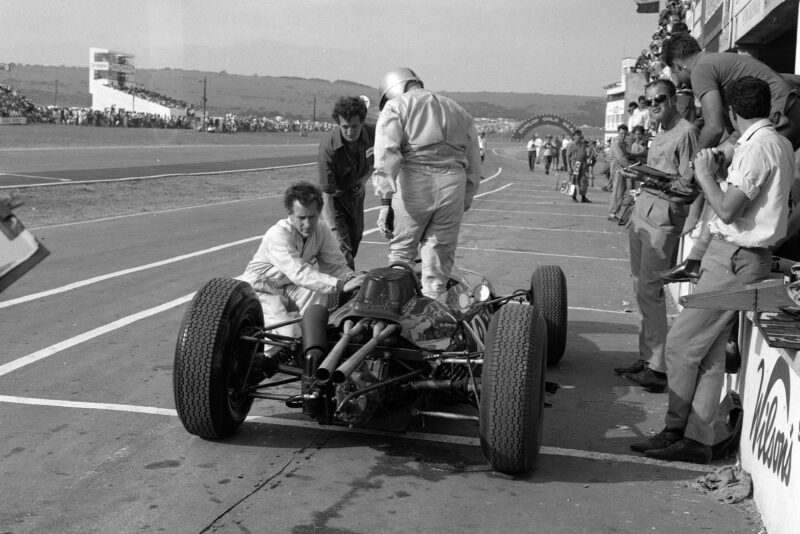
Brabham had to retire with a split fuel tank
Motorsport Images
By halfway Clark was in an unassailable lead with Gurney not far behind. On lap 43 Surtees, who was still third, suddenly came into the pits to retire having blown up in a puff of smoke on the fast downhill curve. Next lap Ginther’s BRM broke a drive shaft just by the universal and he was out. Three laps later Taylor came into the pits with gear selector trouble and it was found that a pinch bolt on the selector mechanism had come loose and when this had been tightened he was off again, having lost three places. On lap 49, Prophet’s Brabham-Ford pulled onto the grass at the esses, the falling oil pressure had finally gone altogether.
Nieman, who had been last since his first pit stop now came in for fuel on his 50th lap. When he pressed the starter button nothing happened and the battery had to be changed before he could regain the race, 19 laps behind Clark. P de Klerk, running last but one, retired on lap 54 with a broken gearbox. On the same lap Taylor passed Love into ninth place. For the next 15 laps positions were unaltered. Although Maggs came into the pits for a further foot cooling, Serrurier came in for water as his radiator was leaking slightly and Blokdyk came in for a refuel, their stays were short and did not affect their positions.
“Although it was good to see Clark win his seventh successive World Championship race in 1963 it would have been better if he had had to fight for it”
The race now entered its final stage. Brabham spun in the esses, splitting his fuel tank and retired in the pits with fuel running everywhere. The only other alteration in positions before the chequered flag was that Blokdyk passed Serrurier three laps from the end, putting him in 11th place. 2hours 10min 36.9 sec after the starting flag fell, the chequered flag brought the race to an end, with Clark 1min 7sec ahead of Gurney and a lap ahead of the third man, G Hill.
Although it was good to see Clark win his seventh successive World Championship race in 1963 it would have been better if he had had to fight for it. For the race must rank as one of the duller Grands Prix of 1963; in fact, many people afterwards were saying the saloon car race was by far the more interesting. Perhaps next year, one team won’t be so much quicker than all the others. Rumour suggested that next year the new 13in Dunlop tyre is likely to be used on all cars.
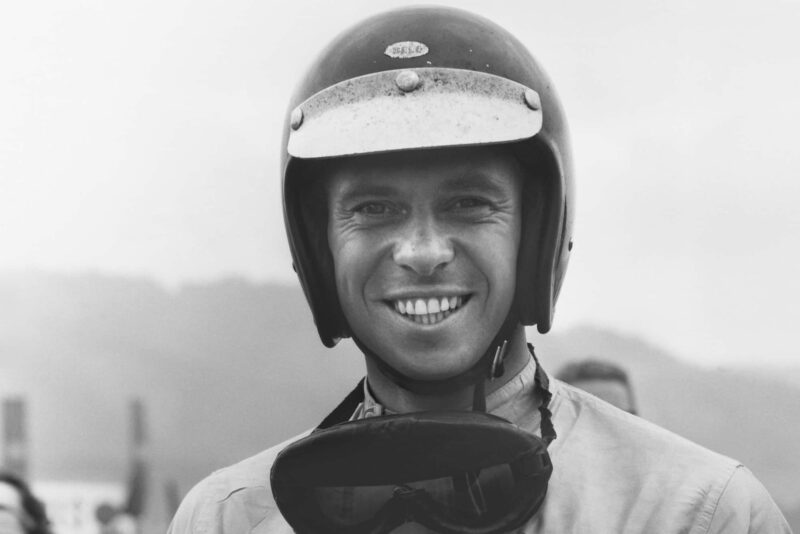
Clark shows his delight at yet another victory
Motorsport Images
